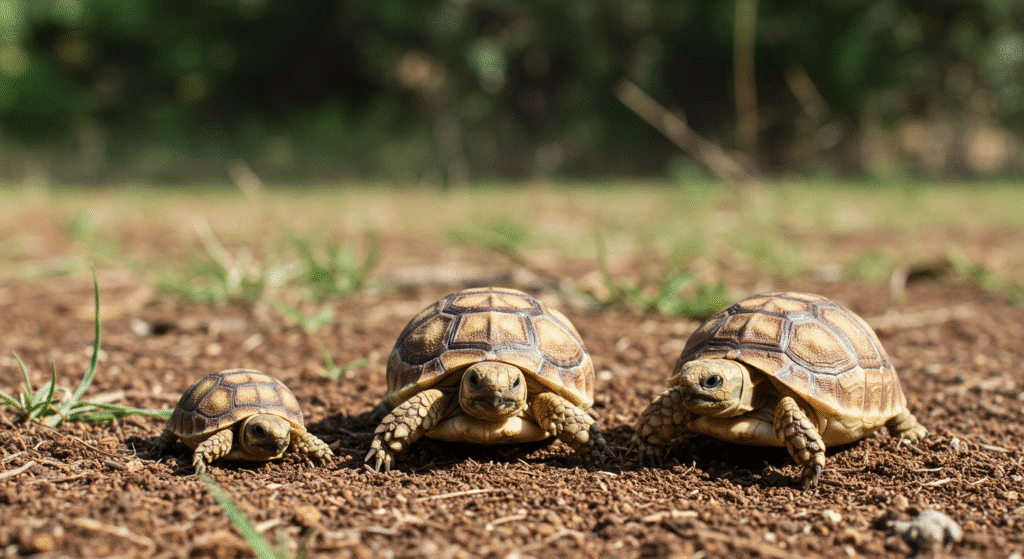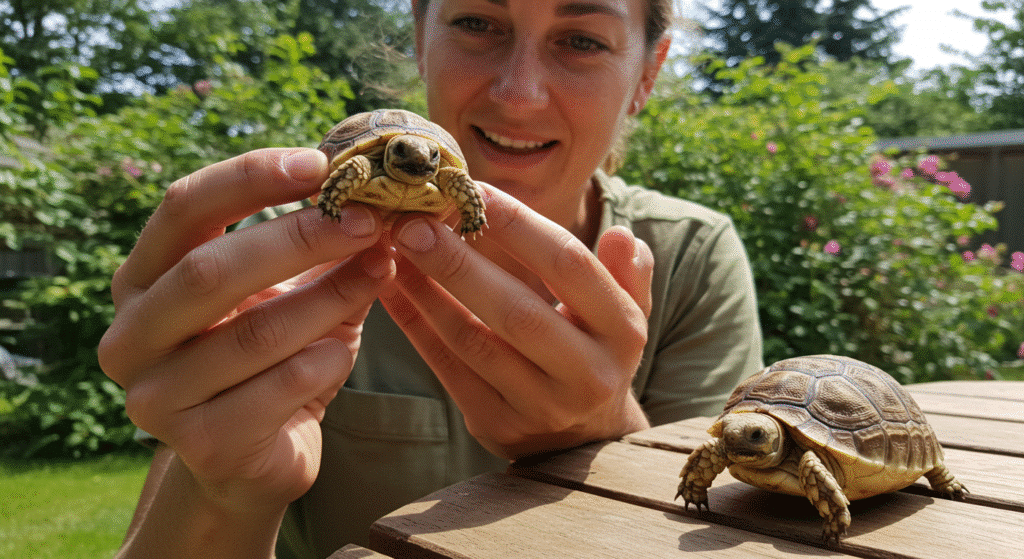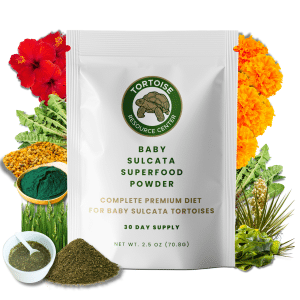When I got my first sulcata, Mel, I assumed that faster growth was better. After all, it became my hobby to find fun foods and treats to feed as well as supplementing with nutrients. But when I learned that baby african spurred tortoises can grow too fast, I was confused. How do I know what is a healthy rate of weight gain and growth?
If you’re raising a baby sulcata tortoise, you’ve probably found yourself obsessing over growth rates. Is your tortoise growing too fast? Too slow? How do you know if that rapid size increase is healthy development or a sign of serious problems ahead? These are some of the most anxiety-inducing questions for new sulcata keepers, and getting the answers wrong can have lifelong consequences for your tortoise.
Here’s the reality: baby sulcata growth rates are more complex than most care guides suggest. While rapid growth might seem like a sign of good health, it can actually indicate overfeeding and lead to shell deformities and health problems. Conversely, slow growth isn’t always bad—it might be perfectly normal for your individual tortoise or environmental conditions.
The challenge is that most growth information available online either gives you vague generalities like “they grow fast” or presents rigid charts that don’t account for individual variation, seasonal changes, or environmental factors. This leaves many keepers wondering whether their tortoise’s growth is normal or a cause for concern.
This guide will give you specific, realistic growth expectations for baby sulcatas at every stage, help you identify when growth rates signal problems, and show you how to support healthy development without creating long-term issues.
Understanding Normal Baby Sulcata Growth Patterns
The first thing to understand is that baby sulcatas don’t grow at consistent rates throughout their development. Their growth follows predictable patterns that vary significantly based on age, season, and environmental conditions. Understanding these natural fluctuations is crucial for proper evaluation.
The First Growth Surge (0-6 months): This is the most dramatic growth period. Just like human babies, they grow superfast when they are brand new.
Did you know if you grew as fast as a newborn until you were 10 years old, you would weigh over 10,000 pounds at age 10? Healthy baby sulcatas can double or even triple their hatchling weight during these first six months. A 20-gram hatchling might reach 60-80 grams by six months under optimal conditions.
This is probably the most important stage for a healthy base diet and an appropriate supplement designed specifically for baby grassland tortoises. However, this rapid growth should be steady and consistent, not explosive. Tortoises that quadruple their weight in just 2-3 months are likely being overfed and may develop serious health problems.
The Sustained Growth Phase (6-18 months): Growth continues at a strong pace but begins to stabilize slightly. During this period, baby sulcatas typically gain 10-20 grams per month, though this varies significantly based on starting size and individual metabolism.
The Transition Period (18-36 months): Growth rates slow noticeably as the tortoise approaches juvenile status. Monthly weight gains may drop to 5-15 grams, and shell growth becomes less dramatic.
Approaching Adult Size (3+ years): Growth continues but at much slower rates. Adult sulcatas may continue growing throughout their lives, but the pace becomes barely noticeable from month to month.

Healthy Growth Rate Guidelines by Age
Hatchlings (0-3 months):
- Starting weight: 15-25 grams
- Expected monthly gain: 8-15 grams
- Target weight at 3 months: 35-60 grams
- Shell length growth: 0.5-1 cm per month
Young Juveniles (3-6 months):
- Starting weight: 35-60 grams
- Expected monthly gain: 10-20 grams
- Target weight at 6 months: 65-110 grams
- Shell length growth: 0.8-1.2 cm per month
Older Juveniles (6-12 months):
- Starting weight: 65-110 grams
- Expected monthly gain: 15-25 grams
- Target weight at 12 months: 180-300 grams
- Shell length growth: 0.8-1.5 cm per month
Yearlings (12-18 months):
- Starting weight: 180-300 grams
- Expected monthly gain: 20-35 grams
- Target weight at 18 months: 300-500 grams
- Shell length growth: 1-2 cm per month
Transition Phase (18-24 months):
- Starting weight: 300-500 grams
- Expected monthly gain: 25-40 grams
- Target weight at 24 months: 600-900 grams
- Shell length growth: 1-1.5 cm per month
Remember, these are guidelines, not rigid requirements. Individual tortoises may fall outside these ranges and still be perfectly healthy.
Factors That Influence Growth Rates
Temperature: This is probably the single most important factor affecting growth rates. Baby sulcatas grow fastest when provided with optimal temperature gradients—basking spots of 95-100°F with cooler areas around 75-80°F.
Consistently cool temperatures can slow growth dramatically, while temperatures that are too high can cause stress and irregular growth patterns.
Humidity Levels: Proper humidity (60-80% during the day) supports healthy shell development and overall growth. Low humidity can slow growth and contribute to shell deformities, while excessively high humidity can cause respiratory problems.
Diet Quality and Quantity: This is where many keepers go wrong. High-quality nutrition supports steady growth, while poor nutrition can either stunt development or cause unnaturally rapid growth that leads to health problems.
Using properly formulated nutrition like our Baby Sulcata Superfood Powder can help ensure consistent, healthy growth by providing the right balance of nutrients without the risks of overfeeding or nutritional imbalances. If you are worried about whether your baby tortoise is getting all the vitamins and minerals it needs, I highly recommend a supplement like this one.

Exercise and Space: Baby sulcatas with adequate space for movement and natural behaviors tend to develop more normally than those kept in cramped conditions. Exercise promotes healthy bone and muscle development alongside proper shell formation.
Seasonal Variations: Many baby sulcatas show seasonal growth patterns, with faster growth during spring and summer months and slower growth during fall and winter. This is normal and shouldn’t cause concern.
Individual Genetics: Just like people, some tortoises are simply genetically programmed to grow faster or slower than others. A consistently slow-growing tortoise that’s otherwise healthy may just have different genetics than a faster-growing sibling.
Warning Signs of Problematic Growth
Too Fast Growth Indicators:
- Doubling weight every 4-6 weeks consistently
- Shell feeling soft or flexible in areas that should be firm
- Development of pyramiding (raised, pyramid-shaped scutes)
- Lethargy despite rapid size increase
- Difficulty of legs supporting increased body weight
Too Slow Growth Indicators:
- No measurable weight gain over 4-6 weeks
- Failure to reach minimum weight guidelines consistently
- Shell appearing stunted or abnormally small
- Lethargy and lack of appetite
- Failure to show normal developmental behaviors and activity
Irregular Growth Patterns:
- Sudden growth spurts followed by complete stops
- Uneven shell development (some areas growing faster than others)
- Dramatic changes in growth rate without environmental changes
- Growth that doesn’t correspond to increasing food intake
The Dangers of Rapid Growth
While fast growth might seem desirable, it often indicates serious problems that can affect your tortoise for life.
Shell Deformities: Rapid growth is one of the primary causes of pyramiding and other shell abnormalities. When tortoises grow too quickly, their shells can’t develop proper structure, leading to permanent deformities.
Metabolic Stress: Unnaturally fast growth puts enormous stress on developing organ systems. The liver, kidneys, and digestive system can be overwhelmed by the metabolic demands of rapid development.
Bone Development Problems: Fast growth can interfere with proper bone formation, potentially leading to weak bones, fractures, or joint problems later in life.
Reduced Lifespan: Some evidence suggests that tortoises that grow too rapidly in captivity may have shorter lifespans than those that develop at more natural rates in the wild.
The Problems with Slow Growth
While slow growth is generally less dangerous than rapid growth, it can also indicate problems that need attention.
Nutritional Deficiencies: Consistently slow growth may indicate inadequate nutrition, either in quantity or quality. This can lead to developmental delays and long-term health problems. Many commercially available tortoise foods have too much protein and not enough fiber. Make sure your tortoise has a diet appropriate for the species.
Environmental Issues: Suboptimal temperatures, humidity, or lighting can slow growth and prevent normal development.
Health Problems: Parasites, infections, or other health issues often manifest as slowed growth before other symptoms become apparent.
Inadequate Care: Sometimes slow growth simply indicates that basic care requirements aren’t being met adequately and your tortoise isn’t comfortable or happy.
Are You Starving Your Tortoise?
Save 10% on premium tortoise food and supplements from Tortoise Resource Center on Amazon now using code BUYNOWGET10

Sulcata Vitamin & Mineral Topper Supplement
30-Day Supply | 2 oz (56 g)
$24.99

Baby Sulcata Tortoise Superfood Powder
30-Day Supply | 2.5 oz (70.8 g) Bag
$24.99
Monitoring Growth Effectively
Weekly Weighing: For baby sulcatas under 6 months, weekly weighing helps track growth patterns and identify problems early. Use a digital scale accurate to at least 1 gram and record the weight in your tortoise growth tracker, which can be downloaded from our bonus pack page!
Monthly Measurements: Measure shell length and width monthly using calipers or a ruler. Track these measurements alongside weight to get a complete picture of development.
Photographic Records: Take monthly photos from consistent angles and distances. These visual records can reveal subtle changes that measurements might miss.
Growth Charts: Keep detailed records of all measurements, weights, and environmental conditions. This data becomes invaluable for identifying patterns and potential problems if you need to discuss with your vet.
Body Condition Assessment: Learn to evaluate your tortoise’s overall body condition—not just weight, but muscle tone, shell quality, and general appearance.
Supporting Healthy Growth
Optimal Environmental Conditions: Maintain consistent temperature gradients, appropriate humidity levels, and proper lighting. These environmental factors have more impact on growth than many keepers realize.
Quality Nutrition: Focus on providing appropriate foods in proper quantities rather than simply maximizing food intake. Quality nutrition designed for the sulcata species supports steady, healthy growth without the risks of overfeeding.
Our Vitamin and Mineral Topper can help ensure your growing tortoise receives all the micronutrients needed for healthy development, which is especially important during rapid growth periods when nutritional demands are highest.
Regular Exercise: Provide adequate space and opportunities for natural movement. Exercise promotes healthy bone development and prevents the muscle weakness that can accompany rapid growth.
Stress Reduction: Minimize handling, maintain consistent routines, and provide appropriate hiding places. Stress can significantly impact growth rates and overall development.
Age-Specific Growth Management
Hatchling Focus (0-6 months): During this critical period, focus on establishing optimal conditions and monitoring growth closely. Small changes in environment or diet can have dramatic effects on development.
Juvenile Management (6-18 months): This is when growth rates are often highest, making it crucial to prevent overfeeding while ensuring adequate nutrition. Monitor for early signs of pyramiding or other developmental problems.
Transition Period (18+ months): As growth begins to slow naturally, adjust feeding schedules and monitor for proper development toward adult proportions.
When to Seek Professional Help
Immediate Veterinary Consultation:
- Complete lack of growth for more than 4-6 weeks
- Extremely rapid growth with shell deformities
- Signs of illness accompanying growth changes
- Sudden dramatic changes in growth patterns
Regular Professional Monitoring: Even healthy, normally growing baby sulcatas benefit from annual veterinary check-ups during their first two years. Professional assessment can identify subtle problems before they become serious.
Professional Growth Assessment: If you’re unsure whether your tortoise’s growth is normal, a reptile veterinarian can provide expert evaluation and recommendations.
Seasonal Growth Expectations
Spring Growth Acceleration: Many baby sulcatas show increased growth rates during spring months as temperatures rise and natural cycles encourage development.
Summer Sustained Growth: Peak growing season typically occurs during warm summer months when environmental conditions are most favorable.
Fall Growth Slowdown: Growth rates often decrease during fall months, even in consistently heated indoor environments. This natural slowdown is normal.
Winter Growth Pause: Some baby sulcatas show minimal growth during winter months. This is generally normal unless accompanied by other health concerns.
Individual Variation in Growth
Genetic Factors: Just like humans, individual tortoises have different genetic growth potentials. Some are naturally faster or slower growers regardless of care quality.
Size at Hatching: Tortoises that hatch larger often continue growing at different rates than smaller hatchlings, even under identical conditions.
Gender Differences: While sex determination in baby sulcatas is difficult, some evidence suggests slight differences in growth rates between males and females.
Origin Variations: Tortoises from different breeding lines or geographic origins may show different growth characteristics.
Creating Your Growth Management Plan
Establish Baselines: Record your tortoise’s initial weight, measurements, and photographs to create a baseline for comparison.
Set Realistic Expectations: Use the guidelines provided here as general targets, but expect some individual variation from these ranges.
Monitor Consistently: Develop a routine for tracking growth that you can maintain long-term. Consistency in monitoring is more important than perfect precision.
Adjust Care as Needed: Be prepared to modify feeding, environmental conditions, or care routines based on your tortoise’s individual growth patterns and needs.
Plan for Long-term Health: Remember that the growth patterns you support now will influence your tortoise’s health for the next 50+ years. Prioritize steady, sustainable development over rapid growth.

The Long-term Perspective on Growth
The growth rate you support during your sulcata’s first two years of life will have lasting impacts on its health, shell formation, and overall quality of life. Tortoises that grow at appropriate rates during this critical period typically develop:
- Strong, well-formed shells without deformities
- Healthy bone density and structure
- Proper organ development and function
- Good muscle tone and mobility
- Resistance to health problems throughout life
Your baby sulcata is counting on you to support healthy, sustainable growth rather than simply maximizing size. The most important thing you can do is educate yourself on the best diet for your beloved tortoise and make sure you are offering appropriate supplements designed for baby sulcatas.
With careful attention to growth monitoring and appropriate care adjustments, you can help ensure your tortoise develops into the strong, healthy adult it’s meant to become. The patience and attention you invest in proper growth management now will benefit your tortoise for decades to come.


